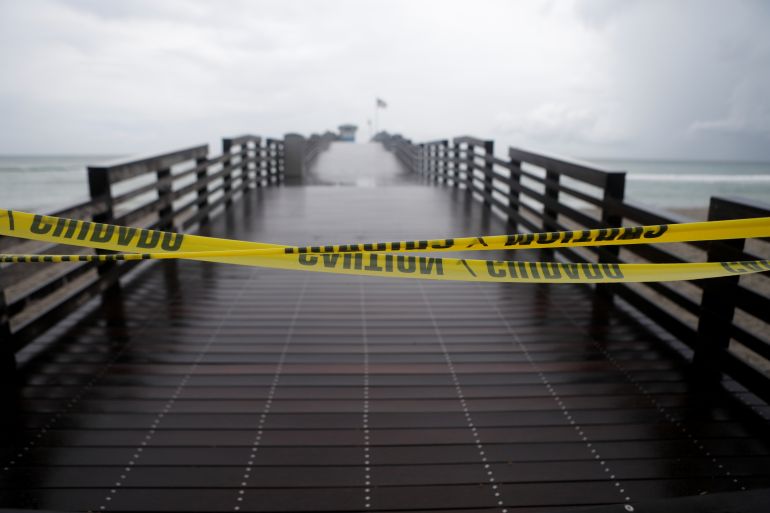Elsa strengthens to hurricane, heads to Florida’s Gulf Coast
NHC warns of life-threatening storm surges, heavy rains, damaging winds and isolated tornadoes as Category 1 storm heads towards Florida’s northern Gulf Coast.

Tropical Storm Elsa strengthened into a Category 1 hurricane on Tuesday, hours before an expected landfall on Florida’s northern Gulf Coast, according to the National Hurricane Center in the United States.
The centre of Elsa was about 100 miles (165km) south-southwest of Tampa, Florida, and was moving north at approximately nine miles per hour (15km/h), with maximum sustained winds of 75mph (120km/h), the NHC said in an 8pm (00:00 GMT on Wednesday) advisory.
Keep reading
list of 4 itemsFast-moving Atlantic Storm Elsa makes landfall in Cuba
Cuba evacuates 180,000 as Elsa continues its approach
Three dead as Elsa batters Caribbean islands, heads for Cuba
In addition to damaging winds and heavy rains, the Miami-based NHC warned of life-threatening storm surges, flooding and isolated tornadoes. A hurricane warning has been issued for a long stretch of coastline, from Egmont Key, in the Tampa Bay region, to the Steinhatchee River some 180 miles (290km) north along the Gulf Coast, with Elsa due to make landfall on Wednesday morning.
Florida Governor Ron DeSantis said the storm was expected to come ashore between 8am and 9am (12:00 and 13:00 GMT) around the Tampa Bay region.
Now is “not a time to joyride” because “we do have hazardous conditions out there,” DeSantis said on Tuesday, warning that the area would take a hard hit from the storm overnight.


Across the Tampa Bay area, which is home to about 3.5 million people, events, government offices and schools were closing down early on Tuesday in advance of the storm. Tampa International Airport shut down at 5pm (21:00 GMT) due to the possibility of storm surges.
Florida Lieutenant Governor Jeanette Nunez called on state residents to start preparing for the storm, including the possibility of power blackouts and asked people to stockpile adequate supplies of food and water.
“If you are asked to evacuate, please leave,” she said, reminding people that there were emergency shelters ready to accommodate them.
After landfall, the storm is forecast to move north-northeast across the southeast of the US during Thursday, dropping between two and four inches (five to 10cm) of rain across the Florida Peninsula.
The storm threatens to impede the search and rescue effort at the site of the condominium building collapse in Surfside, near Miami, where crews have been sifting through rubble for 12 days in hopes of finding survivors. As of Tuesday, 36 people were confirmed dead and 109 were still missing, Miami-Dade Mayor Daniella Levine Cava said.

Farther south, Cubans breathed a sigh of relief as Elsa appeared to have caused little damage, while actually helping to replenish water reservoirs.
The capital city of Havana awoke to overcast skies after a rainy night but no major flooding or damage on Tuesday. Cubans returned to the streets after authorities lifted a tropical storm warning, although heavy rains were set to continue in parts of the country.
“It’s good that Elsa did not cause major damage because we have a really complicated situation here with the coronavirus and now the hurricanes,” said Susana Perez, 68, a retired teacher, queueing up to buy oil amid widespread shortages of goods in Cuba.
Last week, Elsa, which briefly strengthened into the first hurricane of the season, caused at least three deaths and damage to infrastructure and agriculture in Caribbean island nations east of Cuba.
Preliminary damage estimates were at more than $12m in St Lucia and $5.3m in Jamaica, according to government officials.
Elsa’s arrival represented the earliest date that a fifth named storm – which does not typically arrive before August – has struck the region.